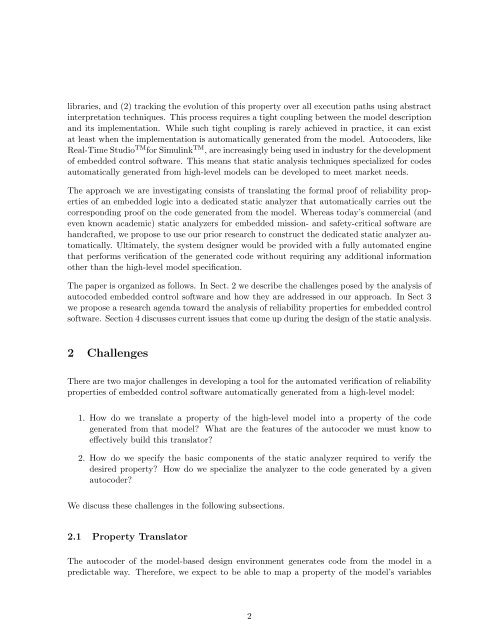Static Stability Analysis of Embedded, Autocoded Software
Static Stability Analysis of Embedded, Autocoded Software
Static Stability Analysis of Embedded, Autocoded Software
Create successful ePaper yourself
Turn your PDF publications into a flip-book with our unique Google optimized e-Paper software.
libraries, and (2) tracking the evolution <strong>of</strong> this property over all execution paths using abstractinterpretation techniques. This process requires a tight coupling between the model descriptionand its implementation. While such tight coupling is rarely achieved in practice, it can existat least when the implementation is automatically generated from the model. Autocoders, likeReal-Time Studio TM for Simulink TM , are increasingly being used in industry for the development<strong>of</strong> embedded control s<strong>of</strong>tware. This means that static analysis techniques specialized for codesautomatically generated from high-level models can be developed to meet market needs.The approach we are investigating consists <strong>of</strong> translating the formal pro<strong>of</strong> <strong>of</strong> reliability properties<strong>of</strong> an embedded logic into a dedicated static analyzer that automatically carries out thecorresponding pro<strong>of</strong> on the code generated from the model. Whereas today’s commercial (andeven known academic) static analyzers for embedded mission- and safety-critical s<strong>of</strong>tware arehandcrafted, we propose to use our prior research to construct the dedicated static analyzer automatically.Ultimately, the system designer would be provided with a fully automated enginethat performs verification <strong>of</strong> the generated code without requiring any additional informationother than the high-level model specification.The paper is organized as follows. In Sect. 2 we describe the challenges posed by the analysis <strong>of</strong>autocoded embedded control s<strong>of</strong>tware and how they are addressed in our approach. In Sect 3we propose a research agenda toward the analysis <strong>of</strong> reliability properties for embedded controls<strong>of</strong>tware. Section 4 discusses current issues that come up during the design <strong>of</strong> the static analysis.2 ChallengesThere are two major challenges in developing a tool for the automated verification <strong>of</strong> reliabilityproperties <strong>of</strong> embedded control s<strong>of</strong>tware automatically generated from a high-level model:1. How do we translate a property <strong>of</strong> the high-level model into a property <strong>of</strong> the codegenerated from that model? What are the features <strong>of</strong> the autocoder we must know toeffectively build this translator?2. How do we specify the basic components <strong>of</strong> the static analyzer required to verify thedesired property? How do we specialize the analyzer to the code generated by a givenautocoder?We discuss these challenges in the following subsections.2.1 Property TranslatorThe autocoder <strong>of</strong> the model-based design environment generates code from the model in apredictable way. Therefore, we expect to be able to map a property <strong>of</strong> the model’s variables2
















